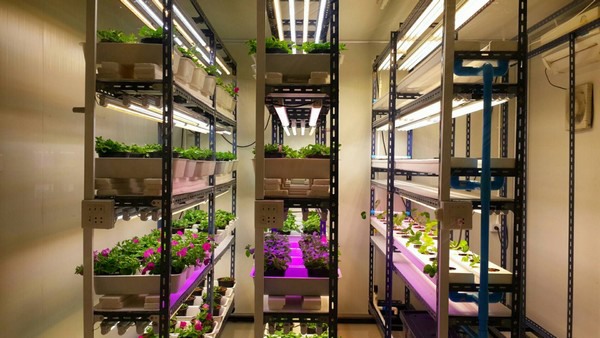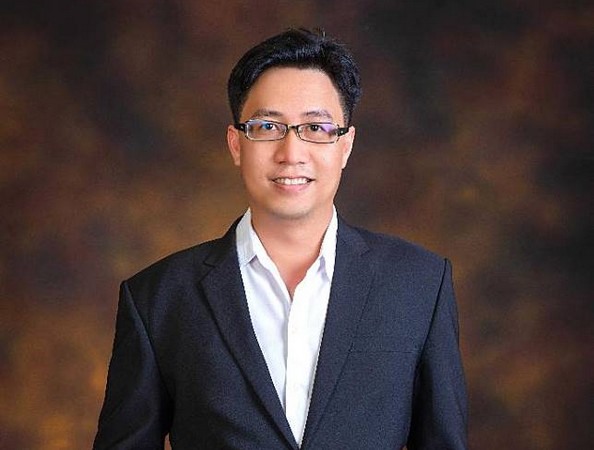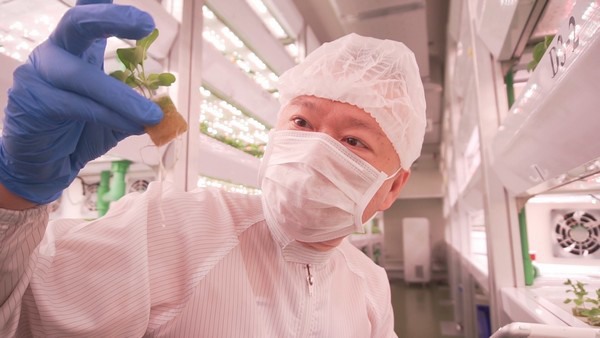"There’s quite a big difference between Thailand and other Asian countries in terms of the advancements in vertical farming technology and business”, Siriwat Sakhonwasee says. After obtaining his PhD on plant biology from the University of California Davis in 2009, Sakhonwasee is now a lecturer and researcher in the faculty of agricultural production at Maejo University, Chiang Mai, Thailand.

Sakhonwasee's university lab research on seed production of petunia under LED lights
Increase of interest
“When I started doing research on vertical farming about 10 years ago, people in Thailand thought that I was pursuing a useless hobby. However, in other Asian countries such as Japan, Korea and Taiwan, vertical farming was already a serious business concept. Today, vertical farming is becoming a new trend where a number of companies are interested to place their bet on. The concept of vertical farming in Thailand receives a lot of influence from Japanese technology. This is why most people use the word “Plant factory”, a jargon, originated from Japan to describe vertical farming.” Last month, Thailand’s Board of Investment (BOI) announced that it officially will support investments on Plant Factories by reducing the tax burden on businesses involved with this technology. Sakhonwasee continues: “I see this as a good sign for vertical farming in Thailand as the same thing happened in Japan a decade ago.
More demand
In terms of Thailand, now there are many more research projects regarding vertical farming than five years ago. “I sometimes have to review research proposals for funding agencies and I can easily tell that nowadays research projects, involving vertical farming concepts, are more frequently submitted”, Sakhonwasee notes. This means that researchers in Thailand will have more chances to explore the science behind the concept of vertical farming. He continues: “Hopefully, this will lead to the development of innovative techniques that are suitable for the country. From a global perspective, people are integrating much more sophisticated technology into vertical farming, such as IoT and AI. The concept is not just growing a plant on the shelves using artificial light anymore. It is about collecting the data and constantly improving the vertical farming system.”

Dr. Siriwat Sakhonwasee
“One thing I see as a clear improvement is the business model of vertical farming. More diverse business models are applied such as a decentralized model by Infarm, harvest on demand by Farmers Cut.” For Thailand, 3 prominent vertical farming startup companies also use a different business model to sell their produce, namely, Wangree Fresh which uses a subscription model to sell their vegetables, NoBitter which is using online channels to engage with its customers and LED Farm which uses a retail hypermarket channel to sell its produce through.
Current industry struggles
“I think that making people understand the value of a vertical farming product, is a common problem for vertical farming worldwide. Recently, Irvin Fain founder of Bowery, used the word “post-organic” to explain the value of their fresh produce. This is such a good way to describe produce from vertical farming that is pesticide-free and very clean so customers do not need to wash before eat.” Sakhonwasee adds: “My colleague recently spoke with Mr. Chingchai Konthansakul founder of LED Farm of Thailand. He has an interesting way of thinking regarding vertical farming produce. He explained that he will never compare vegetables from his vertical farm with traditional farming fresh produce. Instead, he shows off his fresh produce as a novel product. This helped LED Farm to design a proper marketing strategy for consumers who were always skeptical about the safety of fresh produce.”

Mr. Chingchai Konthansakul, founder of LED Farm
Future vision
“In Thailand, I believe that vertical farming will never completely replace traditional farming, in terms of feeding the population. We are blessed with great natural resources that are suitable for almost every aspect of agriculture. But, vertical farming might play a big role in the production of premium produce for high-end consumers. However, to achieve this concept a certification process must be established, like organic produce. I think we will see more diversity in the application of vertical farming systems such as speed breeding and production of medicinal substances from herbs or genetically modified plants.
In other Asian countries, vertical farming will probably play a more prominent role in terms of food production. For example, a small country like Singapore just set a 30 by 30 goal last year. This was done to support the local food production to meet 30% in demand of Singaporean population by the year of 2030. In this case, cultivation area is a big issue and vertical farming is expected to play a significant role in the Singaporean food production. Other examples are countries in the Middle East where majority of land is desert and not arable. Again, vertical farming can overcome this limitation and could provide food security for these countries.”
For more information:
Dr. Siriwat Sakhonwasee, assistant professor
tongscpl@yahoo.com
